Abbey Road (ABR)
Station opened: 31st August 2011
Railway opened: 1846 (part of the Eastern Counties & Thames Junction Railway)
Served by: Docklands Light Railway
Zone: 2/3
Passenger entries/exits (2016/17): 1.204 million
Passenger entries/exits (2016/17): 1.204 million
Stations served (frequency):
- Stratford International (6 trains per hour)
- Woolwich Arsenal (6 trains per hour)
Abbey Road lies on the section of DLR between Canning Town and Stratford International, originally built in 1846 by the Eastern Counties & Thames Junction Railway, and later part of the North London Line between Richmond and North Woolwich. Opened in 2011, it has a small residential catchment area to the east, and light industry to the west, with the Stratford Market Jubilee Line Depot immediately adjoining the station site. Upon exiting the station you are deposited on a bridge that gives the station its name (which itself takes its name from the former nearby Stratford Langthorne Abbey, once the 5th largest abbey in the country until Henry VIII started dissolving them). It's not the most inspiring view it has to be said, faced with construction hoardings on the other side of the road and a row of houses to the left, with a distant sighting of the gleaming rooftops of Canary Wharf over warehouses to the south. The station itself is a standard 2 platform affair, quiet late on a Friday morning. Of particular note is a poster filled with puns on Beatles songs advising confused tourists that this isn't *that* Abbey Road (that one's in St John's Wood).
Abbey Wood (ABW)
Station opened: 30th July 1849
Railway opened: 30th July 1849 (part of the South Eastern Railway)
Served by: National Rail (Southeastern) (& Crossrail in 2018)
Zone: 4
Passenger entries/exits (2016/17): 2.989 million
Passenger entries/exits (2016/17): 2.989 million
Stations served:
- Barnehurst (2tph)
- Dartford(2tph)
- Gillingham (2tph)
- London Cannon Street (6tph via Woolwich Arsenal, 2tph via Sidcup)
- London Charing Cross (2tph)
Acton Central (ACC)
Station opened: 1st August 1853 (as Acton; renamed Acton Central 1st November 1925)
Railway opened: 1853 (as the North and South Western Junction Railway)
Served by: London Overground
Zone: 3
Zone: 3
Passenger entries/exits (2016/17): 1.932 million
Stations served:
- Richmond (4tph)
- Stratford (4tph)
Acton Central today lies on the stretch of Overground between Richmond and Willesden Junction, opened by the North and South Western Junction Railway in 1853 to link between the London and North Western Railway at Willesden and the London and South Western Railway at Kew (hence the name of the company). Acton Central station itself is a two-platform affair, with flower planters dotting the platforms at the southern ends and adding some colour to what is otherwise a very blandly coloured station. Some traces remain of the station's history, including ornate ironwork at the top of the platform canopy supports, but London Overground have very much stamped their orange brand everywhere. Immediately upon taking a picture a very deep voiced man comes on over the tannoy, but I can't make out whether he's telling me off or announcing next weekend's engineering works. Exiting the station brings me to the bustling Churchfield Road, with a row of shops and cafes to the west, and a level crossing immediately to the east (which surely causes quite some congestion in the evening; a steady stream of traffic passes by even in the early afternoon). The area definitely feels a lot busier than my first two locations, both in and out of the station.
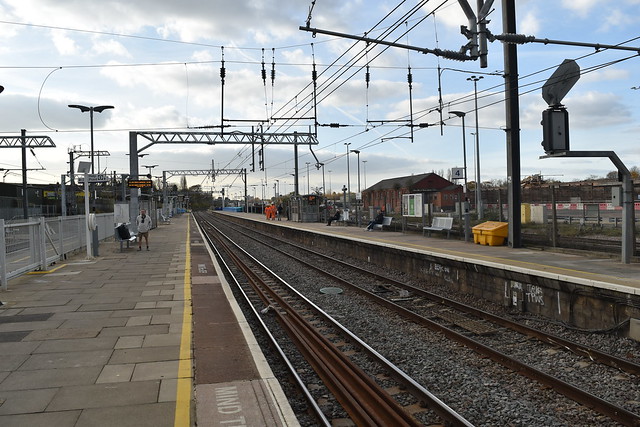
Eventually the 13:51 came into view, and I boarded for the short hop to Ealing Broadway, where I changed for a District line service down to...
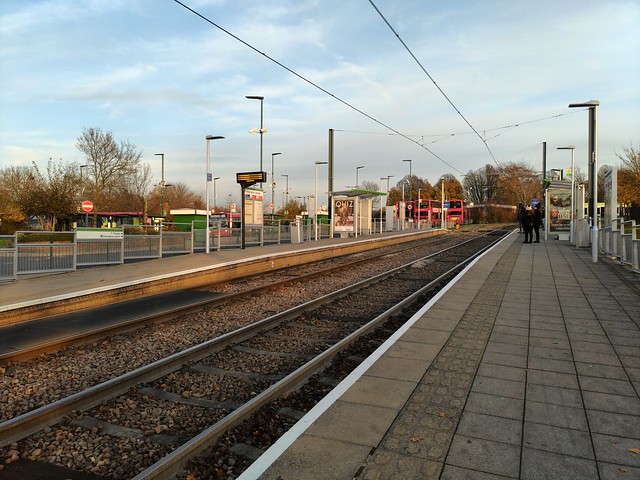
While uploading a picture of the station to Twitter, I nearly fail to spot the tram pulling in to take me on to my next destination, leading to an embarrassing jog up the platform; I wave an apologetic hand to the driver as I board. The tram takes me to Sandilands, where I change for a tram towards Beckenham Junction to alight at...
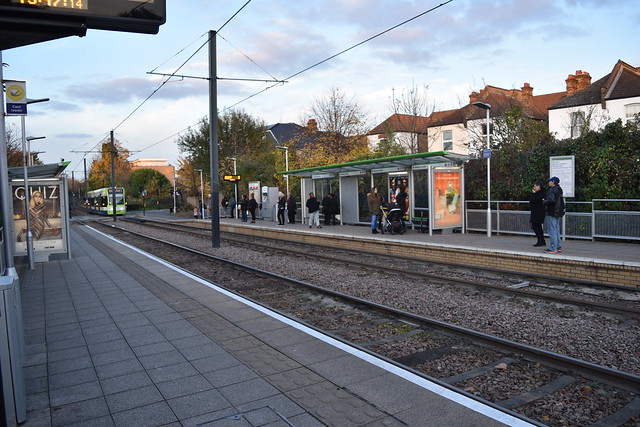
My next destination is a bit of a pain to get to from here, and it's getting dark anyway, so Addiscombe ends up being my finishing point for the first day of this project. Importantly it's been fun, and interesting, so I have high hopes going forward. 7 down, 591 to go...
There are a number of stations with Acton in the name; Acton Central is the first of 3 that start with Acton, and the next would be a right pain in the arse to get public transport to, so I decide to take a 10 minute walk, along residential streets filled with properties which regularly sell for over a million pounds. Goldsmith, Grafton, Messaline and Emanuel combine to bring me to...
Acton Main Line (AML)
Station opened: 1st February 1868 (as Acton; renamed Acton Main Line 1st November 1949)
Railway opened: 4th June 1838 (by the Great Western Railway)
Served by: Great Western Railway (& Crossrail from 2019)
Zone: 3
Passenger entries/exits (2016/17): 0.239 million
Stations served:
- Paddington (2tph)
- Hayes & Harlington (2tph)

Eventually the 13:51 came into view, and I boarded for the short hop to Ealing Broadway, where I changed for a District line service down to...
Acton Town (ACT)
Station opened: 1st July 1879 (as Mill Hill Park; renamed Acton Town 1st March 1910)
Railway opened: 1st July 1879 (by the District Railway)
Served by: London Underground District & Piccadilly lines
Zone: 3
Passenger entries/exits (2016): 6.27 million
Stations served:
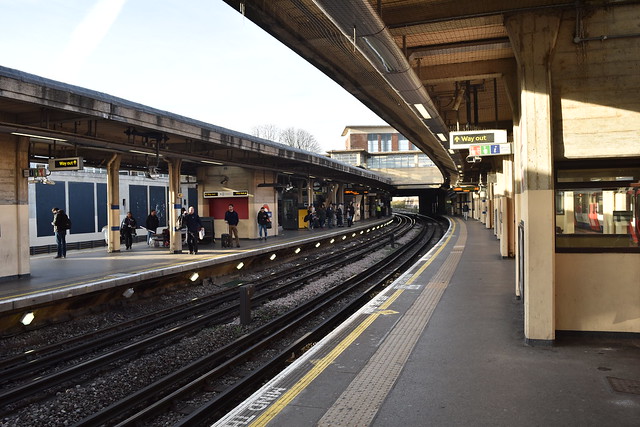
Conveniences taken advantage of, I catch a Piccadilly service to South Kensington, change for a District service to Victoria, change again for a Southern service down to East Croydon then a final change onto a tram to reach...
Addington Village, also known as Addington Interchange, lies on the New Addington branch of the Tramlink system, built in the late 90s and opened in 2000. The station is a standard tram station, with two raised platforms and not a whole lot else; a couple of ticket machines, some information displays and a few bins. Outside the station the main feature is a large bus station (hence Addington Interchange), from which you can catch services to Bromley, Thornton Heath, Purley or even Caterham. The only other notable building I can see is a petrol station on the other side of the roundabout, hidden by trees; the actual Addington Village is a little way down the road.Railway opened: 1st July 1879 (by the District Railway)
Served by: London Underground District & Piccadilly lines
Zone: 3
Passenger entries/exits (2016): 6.27 million
Stations served:
- Upminster (6tph)
- Ealing Broadway (6tph)
- Cockfosters (~17tph)
- Rayners Lane (6tph [2tph continue to Uxbridge])
- Heathrow Terminal 4 (6tph)
- Heathrow Terminal 5 (6tph)
Acton Town, my first Underground station! The station is an important junction between the District and Piccadilly lines, and was opened by the District Railway in 1879 on an extension from Turnham Green to Ealing Broadway. There are 4 platforms, with 1 & 4 generally used by District line trains and 2 & 3 by Piccadilly line trains. Concrete features heavily in the design of the station, with the canopies and supports, and the bridge between platforms all cast in varying shades of unappealing grey. Approaching the ticket hall I pass the station book swap, or at least an empty shelf advertising a book swap. The ticket hall itself is high-ceilinged, with tall windows in the front wall, allowing some of the afternoon light through. The station is a Charles Holden design, or redesign I should say; the station was rebuilt twice, firstly in 1910, and then in 1932 in preparation for the arrival of the Piccadilly line (so maybe I should really say reredesign). Outside the station a steady stream of traffic rumbles over the bridge; on the other side one can see the Transport Museum depot to the north of the station, along with the tangle of tracks that take trains north or west to Ealing. One other feature Acton Town can boast is a toilet, something I'm very grateful for (although I do have to pay for the privilege).

Conveniences taken advantage of, I catch a Piccadilly service to South Kensington, change for a District service to Victoria, change again for a Southern service down to East Croydon then a final change onto a tram to reach...
Addington Village (ADV)
Station opened: 10th May 2000
Railway opened: 10th May 2000 (by Croydon Tramlink)
Served by: Tramlink
Zone: Tram
Passenger entries/exits (2014!): 1.35 million
Stations served:
- New Addington (8tph)
- Wimbledon (8tph)

While uploading a picture of the station to Twitter, I nearly fail to spot the tram pulling in to take me on to my next destination, leading to an embarrassing jog up the platform; I wave an apologetic hand to the driver as I board. The tram takes me to Sandilands, where I change for a tram towards Beckenham Junction to alight at...
Addiscombe (ADS)
Station opened: 23rd May 2000
Railway opened: 19th August 1885 (by the Woodside and South Croydon Joint Railway)
Served by: Tramlink
Zone: Tram
Passenger entries/exits (2014): 1.18 million
Stations served:
- Beckenham Junction (6tph)
- Elmers End (8tph)
- West Croydon (8tph)
- Wimbledon (4tph)

My next destination is a bit of a pain to get to from here, and it's getting dark anyway, so Addiscombe ends up being my finishing point for the first day of this project. Importantly it's been fun, and interesting, so I have high hopes going forward. 7 down, 591 to go...

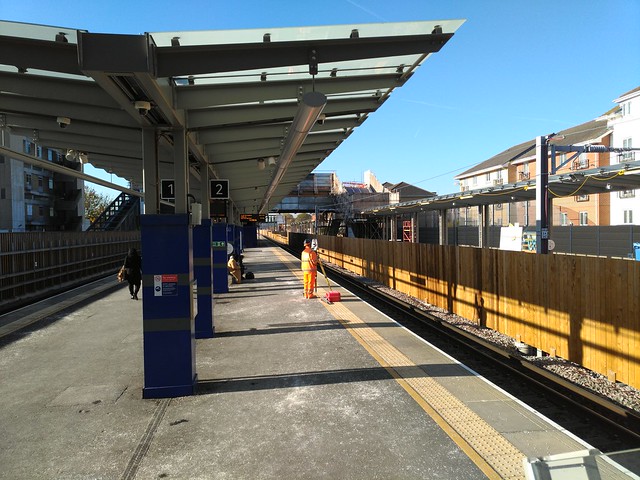

No comments:
Post a Comment